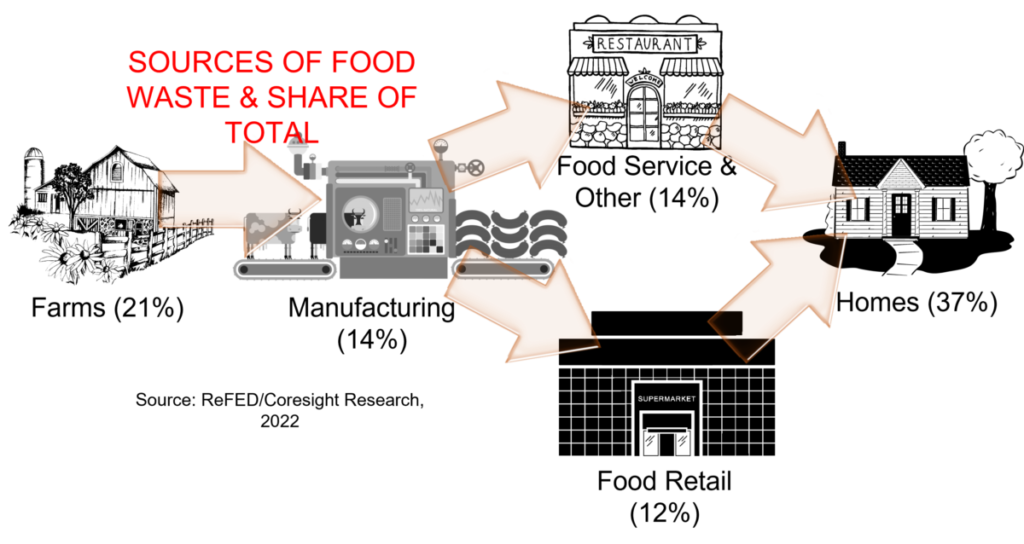Tomorrow, 26 April 2023, is international Stop Food Waste Day. According the Stop Food Waste Day website, “Stop Food Waste Day is the largest single day of action in the fight against food waste. Started in 2017 by Compass Group USA, Stop Food Waste Day is now recognized globally in every corner of the world as we unite to educate and ignite change.” Why all the fuss? As the world’s population continues to increase, finding ways to feed more people is a global priority. Food waste only exacerbates the challenge — and it’s everywhere. Journalist Erica Pandey reports, “America wastes more than 100 billion pounds — or 40% — of its food each year.”[1] She adds, “We often toss food without thinking, but the waste has stakes for the environment, global food insecurity and for our wallets. The biggest share of food waste doesn’t come from barges, grocery stores or restaurants, but from consumers’ own kitchens. The food we waste globally accounts for about 10% of greenhouse gas emissions. If food waste were a country, it would be the third-largest contributor to climate change after the U.S. and China, The Guardian reports. Around 10% — or 13.5 million — of U.S. households experienced food insecurity in 2021, but food that could be donated to those in need is being wasted. And the average American family spends nearly $1900 a year on food they don’t eat, per one paper in the American Journal of Agricultural Economics.”
Everyone is a Stakeholder in the Food Waste Problem
From growers to consumers, everyone in the food supply chain can help prevent food waste. However, unlike many supply chain challenges, consumers constitute one of the largest stakeholder groups when it comes to food waste. Journalist Leen Alkhlaifat explains, “According to the US Environmental Protection Agency, food waste is the largest category of material placed in municipal landfills. In 2019, 35% of the 229 million tons of available food in the US went unsold or uneaten. Food waste consists of rotten vegetables or expired food which releases methane, a problematic greenhouse gas. $418 billion worth of food is wasted every year.”[2] Nevertheless, journalist Wayne Labs notes, “Food loss and waste (FLW) happens on every-level in the supply chain.”[3] He continues, “No matter the data source (e.g., UN’s FAO, U.S. Department of Agriculture, McKinsey, Coresight), and while the numbers may not all perfectly align, it’s easily apparent that FLW is too high. What it comes down to is that 33% to 40% of the world’s food is lost or wasted every year, yet one in nine of the world’s population can’t get enough to eat — that’s equivalent to 800 million suffering from hunger.”
In the 1950s and 1960s, it was not uncommon to hear the phrase, “Eat your food because the poor children in China are starving.” As a child, you didn’t have to be a genius to know that food wasted in America was never going to make it to China or vice versa. That’s one of the problems with the argument that wasted food could be used to feed someone who is hungry. For that to be true, the wasted food needs to be located in proximity to the need — it rarely is. Nevertheless, food waste is a problem that needs addressing. Alkhlaifat reports, “Around the world, food waste has been recognized as an urgent issue requiring immediate action. The United Nations, US Government, European Parliament, and global business coalitions such as the Consumer Goods Forum, have all set goals to cut food loss and waste in half by 2030.”
The Way Forward
Stakeholders along the supply chain each have a contribution to make. Writer Andrea Willige notes, “In developing countries, 40% of losses occur during harvesting and processing. In industrialized countries, 40% of losses happen at the retail or consumer level.”[4] Some of the recommendations for reducing food waste for various stakeholders are found below.

For Consumers
The Stop Food Waste Day website indicates there is a threefold purpose for Stop Food Waste Day: Prevent, Inspire and Repurpose. The site explains each goal this way:
• Prevent food waste at the source by storing food optimally, making use of every edible part of the ingredient and planning meals ahead of time.
• Inspire others to waste less, and repurpose more.
• Repurpose food by redistributing any surplus to your local community, or giving a second life to ingredients that most commonly go to waste.
Pandey adds, “Pay attention while you shop so you don’t over-purchase, plan meals and freeze leftovers, and figure out if you can compost your scraps.”
For Food Sellers
Willige notes, “New digital technologies can help rein in food waste by monitoring food freshness, extending shelf-life and pricing food close to expiry more attractively.”[4] She explains, “Apps like Flashfood and Too Good to Go list goods nearing their expiration date at stores, restaurants and other local food outlets, enabling users to buy them at lower prices. In this way, consumers get a bargain and sellers can claw back money they would typically have written off.” Willige also reports, “For cases where food waste cannot be avoided entirely, a compact composter from Malaysian start-up Maeko converts it into plant feed in only 24 hours. There is no need to dispose of it to landfill sites to generate methane and other greenhouse gases. The composter comes in both commercial and domestic sizes, enabling businesses, schools and hospitals as well as households to contribute to a more circular, sustainable food system.” Labs adds, “Some retailers are now working with volunteer groups (especially in urban areas) to shift unspoiled, slightly out-of-date tomatoes and other produce to people who have been hit with food insecurity. There are other options for decreasing waste. One example is the increase of vertical farming to bring the growing of produce closer to the markets they serve, cutting supply chain distances.”
For Supply Chain Stakeholders
New digital technologies can also help all along the supply chain. Willige reports, “A food freshness platform from Tata Consultancy Services, monitors food quality along the entire product journey. The system takes inputs from connected sensors installed at every stage of the supply chain, from ‘farm to fork’, to assess food products’ freshness. This live data is also fed into a digital twin of the real-world supply chain to simulate different environmental conditions that can affect the lifespan of food. This can include changes in temperature, humidity, air quality and light intensity. For example, the platform can anticipate the shelf-life of potatoes for different applications — as chips, fries or potato starch — by considering aspects such as fungal growth or change in sugar content over time. Suppliers and retailers can then use this information to adapt how they are handled at each stage of the ripening process.” McKinsey & Company analysts add, “Forward-thinking companies are actively engaging with suppliers to map food loss “hot spots” in the supply chain and to understand their causes. Some companies are developing (and providing public access to) an integrated database of suppliers’ performance across locations. Others are conducting an annual external audit or requiring third-party assessment of suppliers’ performance on this issue. A few best-practice companies are using digital technologies, like blockchain, to make products traceable at every stage along the journey from farm to store. Don’t wait for perfect data; just gather enough information to sense the scope of the problem. Generating awareness of how much loss happens — and where — is an important first step in creating urgency for change.”[5]
For Growers
Journalist Adele Peters reports, “Around 2.5 billion metric tons of food is wasted on farms each year — that’s nearly twice as much as in previous estimates.”[6] McKinsey analysts add, “At harvest, we estimate that one-third of the loss is linked to production surplus (the farm produced more food than it could sell), another third consists of food that is edible but doesn’t meet customer specifications, and the remaining third is because of damage that renders the food inedible. In short, two-thirds of the loss is edible and could be safely redirected to human consumption.” Peters agrees there are strategies that can help reduce food waste by growers. She writes, “A variety of solutions can help on farms, including increasing demand for so-called ugly produce that supermarkets used to reject.” Farm owner and advocate Beverley Flatt notes, “Food doesn’t make it from the farm to the market for a variety of reasons. Regulatory processes, market demand and even consumer preferences pressure farmers to grow nearly perfect produce, which isn’t always realistic. However, a portion of food waste can be managed through agricultural industry innovations and farmer ingenuity.”[7] Nevertheless, Flatt notes, farmers face numerous obstacles in their efforts to reduce waste, including: Overproduction to manage risk; impact of weather; food and safety rules; dealing with damaged and disfigured foods; and lack of labor. Concerning the latter area, she notes, “Outside of political debates, solutions remain focused on mechanical harvesting. From color-sensitive robots that can select ripe-versus-unripe tomatoes to tractor attachments that can harvest and pulverize pumpkins quickly, the move to mechanical labor is an option many farmers are investing in.”
Concluding Thoughts
Willige concludes, “Wasted food further threatens the resilience of our food systems at a time when they are already struggling and a global food emergency is looming. Food wastage not only deprives us of food, but it also squanders the production resources used to make it.” As the above discussion makes clear, there are no silver bullet solutions to food waste challenge. This is truly an area where letting “a thousand flowers bloom” is a preferred strategy. Flatt asserts, “Completely eliminating all food waste either on the farm or in the home is a lofty goal. However, every small change to reduce the amount of food lost is a step in the right direction when it comes to feeding a hungry planet.”
Footnotes
[1] Erica Pandey, “America’s staggering food waste problem,” Axios, 4 December 2022.
[2] Leen Alkhlaifat, “Why science is not enough to tackle food waste,” The Boar, 3 January 2023.
[3] Wayne Labs, “Food Loss & Waste: It’s Everywhere in the Supply Chain,” Food Engineering, 28 November 2022.
[4] Andrea Willige, “5 ways tech can help reduce food waste,” World Economic Forum, 13 February 2023.
[5] Moira Borens, Sebastian Gatzer, Clarisse Magnin, and Björn Timelin, “Reducing food loss: What grocery retailers and manufacturers can do,” McKinsey & Company, 7 September 2022.
[6] Adele Peters, “Oops! Farms are wasting twice as much food as we thought,” Fast Company, 20 July 2021.
[7] Beverley Flatt, “Minimizing Food Waste on Farms,” U.S. Farmers & Ranchers, 3 June 2020.





